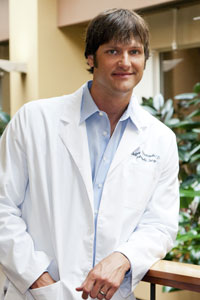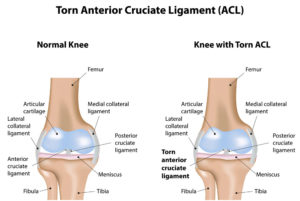Anterior Cruciate Ligament (ACL) Tear Specialist

Are you an athlete who participates in sports that involve jumping or quick stopping? If so, you may be at risk of tearing your anterior cruciate ligament, or ACL. An ACL tear is one of the most common injuries suffered by athletes. ACL tear specialist, Dr. Jeff Padalecki provides diagnosis and both surgical and nonsurgical treatment options for patients in Austin who have suffered a torn ACL. Contact Dr.Padalecki’s team today!
What is an Anterior Cruciate Ligament Tear (ACL Tear)?
The ACL, or anterior cruciate ligament, is one of the four major ligaments of the knee. The ACL prevents the shinbone (tibia) from sliding out in front of the thighbone (femur). Most frequently seen in athletes or those who participate in sports, ACL injuries range in severity from small strains to a complete ACL tear. ACL injuries tend to occur during particular activities that involve sudden stops or changes in direction, causing the knee to buckle or shift. Soccer players, especially females, are highly prone to suffer an ACL knee injury; however, other sports such as tennis, basketball, and football can also carry a high injury-rate. Dr. Jeff Padalecki, knee specialist serving Austin, Round Rock, and Cedar Park, Texas communities, specializes in returning patients to the activities they love following an anterior cruciate ligament injury, such as a torn ACL.
What are the symptoms of an ACL Tear?
An ACL injury of the knee will most always bring swelling, pain, and limited range of motion. The symptoms will vary based on the severity of the injury. In the case of a mild injury, the knee may feel slightly unstable or might “give way.” In more severe cases, patients may describe a “popping” sensation at the time of the injury and the knee will begin to swell soon afterwards. Pain is very common in this type of injury when weight is placed on the foot.
How is an ACL Tear Diagnosed?
Dr. Padalecki will conduct a thorough examination of the knee and look for any deformities or changes in the appearance of the knee in comparison to the uninjured one. A variety of tests may be utilized to determine the extent of the injury and may consist of using X-rays to rule out any fractures in the knee. MRI can be helpful in evaluating ligaments, tendons and cartilage.
How is an ACL Tear Treated?
The treatment for an ACL injury will vary based on the severity of the injury itself and whether or not there is damage to other areas of the knee. The aim of treatment is to reduce pain and swelling and restore stability and motion back into the knee.
Non-Surgical
Some ACL injuries can be treated with a combination of ice, heat, rest, elevation, and avoidance of certain activities. Some ACL injuries may benefit from physical therapy to strengthen the knee and increase range of motion.
Surgical
In more severe cases where the ACL is completely torn, or stretched beyond its natural limits, surgery is usually the best option to restore normal function to the knee. The treatment of choice is an arthroscopic ACL reconstruction where the ligament is replaced with a graft. There are many graft options and Dr. Padalecki will discuss the pros and cons of each graft during your visit.
What is the Recovery Time After ACL Tear Surgery?
A rehabilitation program will be prescribed at your first post-operative visit with Dr. Padalecki. Initially, the therapy will focus on returning motion back to the injured knee and surrounding muscles. After that is achieved, you will follow a progressive strengthening program to protect the new ligament. With proper and careful treatment, you will be able to resume normal activities within six to nine months.
For more information on an anterior cruciate ligament injury, or for additional details on ACL tear treatment, please contact the office of Dr. Jeffrey Padalecki, knee specialist in Austin, Texas.
